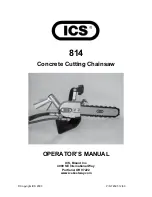
13
HTMA REQUIREMENTS
FLOW RATE
TOOL OPERATING PRESSURE
(at the power supply outlet)
SYSTEM RELIEF VALVE SETTING
(at the power supply outlet)
MAXIMUM BACK PRESSURE
(at tool end of the return hose)
Measured at a max.
fl
uid viscosity of:
(at min. operating temperature)
TEMPERATURE
Suf
fi
cient heat rejection capacity
to limit max.
fl
uid temperature to:
(at max. expected ambient temperature)
Min. cooling capacity
at a temperature difference of
between ambient and
fl
uid temps
NOTE:
Do not operate the tool at oil temperatures above 140° F (60° C). Operation at higher temperatures can cause operator
discomfort at the tool.
FILTER
Min. full-
fl
ow
fi
ltration
Sized for
fl
ow of at least:
(For cold temp. startup and max. dirt-holding capacity)
HYDRAULIC FLUID
Petroleum based
(premium grade, anti-wear, non-conductive)
VISCOSITY
(at min. and max. operating temps)
NOTE:
When choosing hydraulic
fl
uid, the expected oil temperature extremes that will be experienced in service determine the
most suitable temperature viscosity characteristics. Hydraulic
fl
uids with a viscosity index over 140 will meet the require-
ments over a wide range of operating temperatures.
*SSU = Saybolt Seconds Universal
4-6 gpm
7-9 gpm
11-13 gpm
9-10.5 gpm
(15-23 lpm)
(26-34 lpm)
(42-49 lpm)
(34-40 lpm)
2000 psi
2000 psi
2000 psi
2000 psi
(138 bar)
(138 bar)
(138 bar)
(138 bar)
2100-2250 psi 2100-2250 psi 2100-2250 psi 2200-2300 psi
(145-155 bar) (145-155 bar) (145-155 bar) (152-159 bar)
250 psi
250 psi
250 psi
250 psi
(17 bar)
(17 bar)
(17 bar)
(17 bar)
400 ssu*
400 ssu*
400 ssu*
400 ssu*
(82 centistokes) (82 centistokes) (82 centistokes) (82 centistokes)
140° F
140° F
140° F
140° F
(60° C)
(60° C)
(60° C)
(60° C)
3 hp
5 hp
7 hp
6 hp
(2.24 kW)
(3.73 kW)
(4.47 kW)
(5.22 kW)
40° F
40° F
40° F
40° F
(22° C)
(22° C)
(22° C)
(22° C)
25 microns
25 microns
25 microns
25 microns
30 gpm
30 gpm
30 gpm
30 gpm
(114 lpm)
(114 lpm)
(114 lpm)
(114 lpm)
100-400 ssu* 100-400 ssu* 100-400 ssu* 100-400 ssu*
(20-82 centistokes)
TOOL CATEGORY
HYDRAULIC SYSTEM
REQUIREMENTS TYPE 1 TYPE II TYPE III TYPE RR
NOTE:
These are general hydraulic system requirements. See tool Speci
fi
cation page for tool speci
fi
c requirements.
Summary of Contents for CS11
Page 2: ...2 ...
Page 22: ...22 CS11 PARTS ILLUSTRATION ...











































